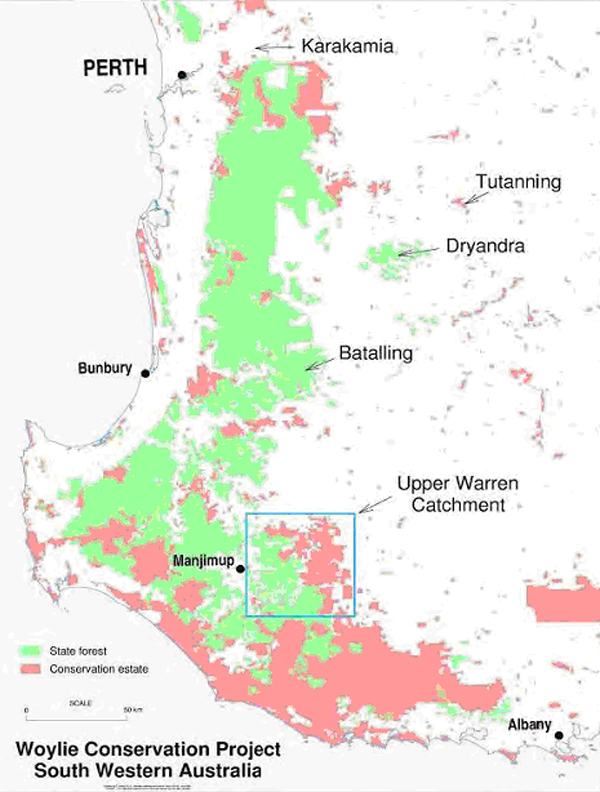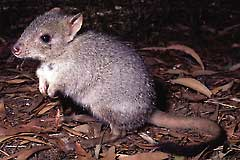Analysis of Upper Warren Woylie Data
Overview
The Problem:
Is the woylie population declining in the Upper Warren region, and if so, what is causing this decline?
The Data Analysis Australia Approach:
To use a combination of modelling techniques (including generalised linear models) to investigate the health and status of the woylie population.
The Result:
The models show a decline in the existing woylie population, however, identifying the cause of this decline is more problematic and may be related to an acute endemic disease.
The Problem

The woylie (Bettongia penicillata) was removed from the endangered list after the Western Shield fox baiting program and translocations led to a recovery in woylie numbers. Recent investigations have suggested that there may be a substantial decline in the abundance of woylies in the South West forests of Western Australia. Although this decline had not yet been statistically verified, indications suggested the decline to be extreme enough that immediate action may need to be taken, including the possible reinstatement of woylies to the endangered species list. A definitive and independent review of the historical trapping data to give an objective statement regarding the decline (or otherwise) of the woylie population was therefore required.
Woylie trapping data in the Upper Warren region had been collected over a number of years for long-term monitoring research (P. Christensen and N. Burrows), the "Kingston Study" into timber harvesting impacts and associated research (A. Wayne), Western Shield monitoring and other Donnelly District activities (I. Wilson). Notably, the data had not been specifically collected for the purposes of Data Analysis Australia's analysis and as such had several impacts on the modelling. In particular, there was a lack of data available for each site, trapping was not performed consistently for the different research projects, there were changes in site boundaries and various individuals completed the data collection and data entry.
In saying this, the data that has been collected is extensive and is the richest source of woylie data available for this analysis.
The Data Analysis Australia Approach
A multistage conditional approach was adopted, examining in sequence the population size, then the demographics (age and gender) and finally condition (weight and size). By making each analysis conditional on the previous stages, relationships could be examined using generalised linear models, an extension to standard regression techniques.
Due to the discrete response variables involved, a generalised linear model was used to analyse changes in the woylie population and demographics. This was a natural progression from using linear regression models, to deal with the issue of binary response data.

The introduction of a quasibinomial model allows for the distribution to be specified entirely by the mean and variance functions for binary variables, whilst allowing for additional variation in the data compared to that which would be expected under the binomial distribution. This additional variation is expected for variables such as the trapping rates since it is likely that each trap night at a site will not be statistically independent of other trap nights.
The body condition index of individual woylies was used to analyse the general health and fitness of the woylie population and, in particular, any changes over time. As there were multiple measures of the same individual at different time periods, within- and between- woylie variation was accounted for by using a linear mixed model in which woylie identity (ID) was included as a random effect. Fixed effects included the sex, hindfoot and head length of the individual and the interaction between the length parameter and se
The Result

The Data Analysis Australia model provides strong evidence of a major decline in the woylie population since 2002.
Inspection of the average condition index shows that there appears to be an increasing trend in most sites over time, suggesting that there may be an increase in the overall health of the existing woylie population. Other results were that the proportion of breeding female woylies has remained approximately constant over time, and that their native predator, the Chuditch, and their natural competitors, the Quenda and the Common Brushtail Possum, do not seem to have an impact on the woylie population size.
Overall, the results indicate that the population decline does not seem to be influenced by the body condition or the demographics/biometrics of the woylie population.
So, what is driving the decline of this population? Data Analysis Australia attended a woylie symposium in which collaborators for the Woylie Conservation Research Project presented their findings. It was found that the leading hypothesis of the causes of woylie declines in the Upper Warren region is primarily due to an acute endemic disease. The symptoms and confirmation of the disease remains elusive at this stage, although some key suspects have been identified including Toxoplasma, Trypanosoma sp. nov. and possible synergistic effects between these two parasites and the involvement of stressors that may trigger the disease.
October 2008
